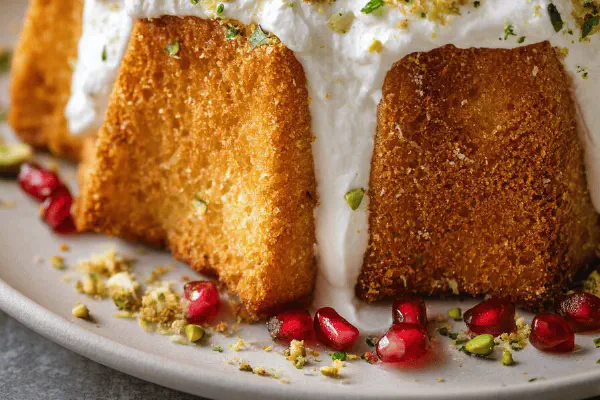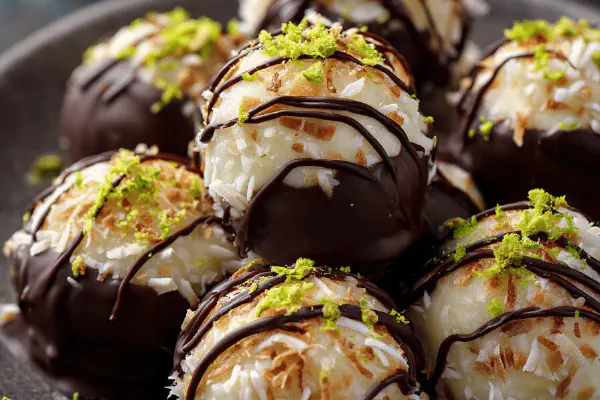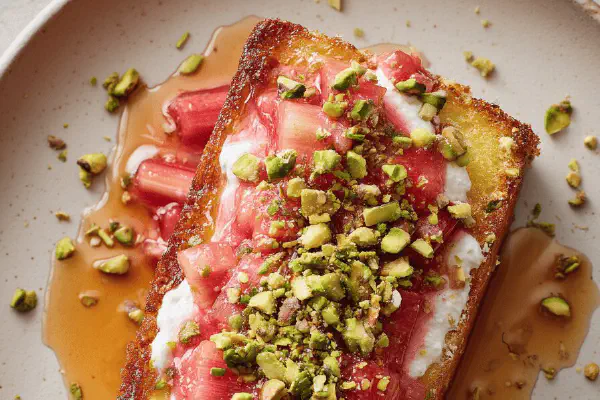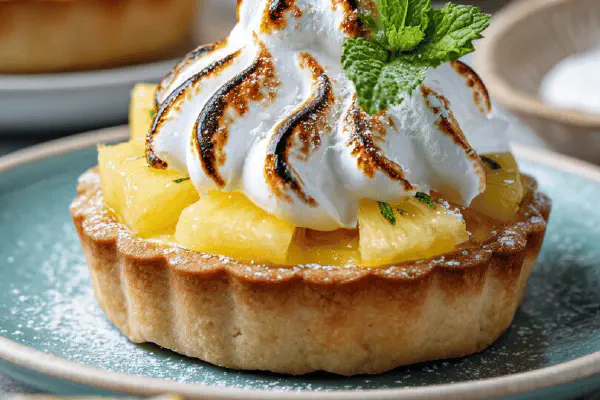Blood Orange Chiffon Cake

By Emma
Certified Culinary Professional
Ingredients
Blood Orange Chiffon Cake
- 133 g (1 cup) all-purpose flour unbleached
- 5 ml (1 teaspoon) baking powder
- 1 ml (1/4 teaspoon) salt
- 6 large eggs at room temp separated
- 2.5 ml (1/2 teaspoon) cream of tartar
- 260 g (1 1/4 cup) light brown sugar divided
- 2 blood oranges well washed, zest finely grated and juice extracted (85 ml / 1/3 cup)
- 125 ml (1/2 cup) extra virgin olive oil
- 5 ml (1 teaspoon) pure vanilla extract
- 2.5 ml (1/2 teaspoon) freshly ground cardamom pods powder
Blood Orange Chantilly
- 1 blood orange, washed
- 500 ml (2 cups) heavy cream 35%
- 90 g (1/3 cup +1 tablespoon) granulated sugar
Decoration
- 3 pistachios roughly chopped
- A handful of pomegranate arils
About the ingredients
Method
Preparation
- Heat oven. Middle rack at 160 °C (320 °F). Lower temp slightly. Reason? Olive oil brown quicker, prevent overcooked edges.
- Sift flour, baking powder, cardamom powder, and salt into a bowl. Keep close. This dry mix ensures even lift and spice distribution.
- Separate eggs carefully: whites in large, clean metal bowl — no yolk allowed; yolks in separate bowl. At room temp, whites will whip better; cold whites resist volume.
- Add cream of tartar to whites. Start whipping slow, gradually increasing speed as foam forms.
- Add 130 g (half) of the brown sugar slowly once soft peaks appear. Keep whipping till stiff, glossy peaks form. Meringue glistens, holds shape without drooping. If overbeaten, looks grainy, breaks apart — no good.
- In separate bowl, whisk yolks with remaining 130 g sugar till thick, pale. Add zest, juice of blood oranges, olive oil, and vanilla. Whisk smooth. Olive oil gives richer flavor than neutral canola; subtle fruitiness.
- Fold dry ingredients gently into yolk mix using rubber spatula, careful not to deflate.
- Take about 1/3 of the meringue, fold into yolk batter to lighten it. Be gentle—lift and fold from bottom up. Pass over the bowl edges slowly.
- Fold in remaining meringue in two batches, with gentle, slow turns. Overmix and cake sinks; undermix leaves lumps.
- Pour batter into ungreased 25 cm (10 inch) angel food pan — no oil or parchment. The batter clings and climbs while baking, helps rise.
- Bake 50-55 minutes until top springs back slightly when touched, and toothpick inserted in center comes out clean or with a few moist crumbs adhering. The crisp top, slight golden hue, but no dryness.
- Immediately invert pan onto cooling rack or bottle neck. Gravity prevents collapse, allows maximum air.
- Let cool at least 2.5-3 hours fully. Backbone of chiffon comes as cake cools hanging upside down. Patience pays.
- Run thin knife blade between pan and cake to loosen gently. Out it comes. If stuck, wiggle carefully or briefly warm sides with kitchen torch or warm towel.
Chantilly and Segments
- Zest finely half orange and reserve separately. Use zester or microplane only for fine aromatic oils.
- On other half, zest longer strips with peeler, keep for decoration.
- Slice ends off the orange to create flat bases. Place flat on cutting board. With a sharp paring knife, remove skin and white pith as close as possible to flesh. No bitter membrane left.
- Hold orange, cut Supreme segments between membranes. Juicy slivers perfect for topping.
- Use chilled bowl and whisk, whip 500 ml cold cream with 90 g sugar and fine orange zest.
- Whip till soft peaks form — quite firm but still creamy. Overbeating? Clumpy, starts breaking. Underbeat? Runny. Perfect balance is silky stiff peaks with some bounce.
- Transfer stuffed cream into piping bag fitted with Saint-Honoré tip or star if unavailable.
Assembly
- Pipe cream over cake top, starting center, moving outward in gentle waves or loops — rhythm matters for appearance.
- Sprinkle chopped pistachios finely atop chantilly. Use fingers, press lightly in so they stick.
- Scatter pomegranate arils sparingly for juicy burst and color contrast.
- Arrange blood orange supremes and long zest strips artistically. Balance visual, flavor, texture lines.
- Serve at room temp or lightly chilled. Watch cream soften but cake stays airy.
Tips & Tricks
- Egg temperature: whites whip best at room temp; separate eggs cold, then warm yolks & whites individually for best volume.
- If meringue weeps liquid, sugar possibly added too fast or too little cream of tartar. Check sugar distribution carefully.
- No angel food pan? Tube pan ungreased OK; otherwise grease slightly but texture varies.
- Olive oil delivers depth. If using canola, add a pinch more zest to punch flavor back.
- Cardamom: subtle spice, optional but adds warmth against citrus. Replace with cinnamon for sweeter notes.
- Cake shrinks? Underbaking or premature unmolding. Don’t rush.
- Chantilly: Use cold enough cream and bowl; beat signals you know by texture, not time. Add zest late to preserve oils.
- Pomegranate and pistachios for crunch and tartness -- keep balance, too much overwhelms delicate layers.
- If cake cracks on top, batter overmixed or oven temp too high. Adjust and learn your oven quirks.
- Use toothpick or skewer test, but mainly look for slight golden domed top, springy texture to fingers.
- Cooling upside down is non-negotiable—skip it and cake falls flat, dense.
- Try folding meringue with chopsticks for gentler control.
- Serve in slices that show bright red-orange segments and crunchy bits. Texture contrast is everything.
Cooking tips
Chef's notes
- 💡 Egg whites at room temp whip better; cold whites resist volume. Separate eggs cleanly, no yolk traces. Cream of tartar added aids stability; add slow sugar once soft peaks show clean glossy stiff peaks form. Overbeating makes grainy, dry texture; underbeating won’t hold shape.
- 💡 Folding needs patience; fold 1/3 meringue into yolks first to lighten mix before adding rest gently. Use rubber spatula, scoop from bottom up, pass over edges slowly. Overmix knocks out air, cake sinks; undermix leaves lumps stubborn. Batter should be airy but fully combined.
- 💡 Olive oil browns faster than canola; oven temp lowered 10°C helps prevent edge overcooking. Watch golden dome forming, not too dark or dry. Toothpick test—clean or moist crumbs okay; no wet batter. Invert pan immediately once out to avoid collapse; gravity holds airy crumb in place.
- 💡 Chantilly cream cold, whip with sugar and fine orange zest till soft peaks only. Overwhip and it clumps, breaks. Underwhip leaves runny cream. Pipe with Saint-Honoré tip or star for texture contrast. Add zest late to keep oils fresh; too early loses aroma.
- 💡 Pistachios chopped fresh, not salted or roasted—too strong overpower subtle cake layers. Pomegranate arils add juicy sharpness but sparingly, can overwhelm. Chunky pistachios contrast with tender crumb. Keep balance visually and taste-wise. Arrange zest strips and supremes to catch the eye, add bite and chew.
Common questions
How to avoid flat cake?
Folding crucial. Overmix kills air, underfold leaves lumps. Egg whites whipped right temp, cream of tartar added helps hold foam. Baking temp lowered; olive oil browns faster. Invert pan immediate after bake traps air. Cooling time non-negotiable, patience wins structure.
Can canola oil replace olive oil?
Yes, but mild flavor. Add more zest to recover citrus depth. Olive oil adds earthy fruity notes unique here. Watch temp closely, canola tolerates heat better. Adjust baking temp if swapping fats, olive oil demand lower heat to avoid drying edges.
Meringue weeping liquid?
Sugar added too fast or cream of tartar missing. Whip slow, add sugar gradually after soft peaks form. Low acid = unstable foam. Separate eggs cleanly, no yolk grease or water. Chill bowl helps for chantilly. Rescue meringue problems by restarting slow whip if needed.
How best to store cake?
Wrap loosely in plastic to avoid moisture buildup, but cake best eaten within 24 hours. Chantilly pipe fresh or chill separately, pipe before serving if possible. Refrigerate but avoid soggy crumb from condensation. Leftovers dry over time, refresh with light syrup if needed.



